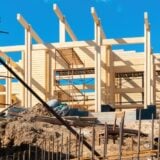The latest figures from the National Association of Realtors show that existing home sales surged 10.1% in October while total housing inventory fell 3.7%.
‘The supply of homes on the market is now at the lowest level in over two and a half years.
We’re getting closer to a general balance between buyers and sellers,’ said Lawrence Yun, NAR chef economist.
‘In fact, low end inventory has become very tight in many areas and in some cases buyers are becoming more aggressive, NAR President Viki Cox-Golder.
Existing home sales are now 23.5% above what they were in October 2008 and overall sales activity is at the highest pace since February 2007.
Yun said he was surprised at the size of the gain.
‘Many buyers have been rushing to beat the deadline for the first time buyer tax credit that was scheduled to expire at the end of this month,’ he said.
He is predicting similarly robust sales for November followed by a measurable decline in December and early next year before another surge in spring and early summer.
Now that the tax credit has been extended and expanded, potential buyers have until April 30 next year to have a contract in place.
‘There is still a large pent-up demand that can be tapped before the tax credit expires.
Our recent consumer survey shows that 13% of successful first time buyers had a previous contract that was cancelled or fell through.
So there are likely to be many more buyers who were attempting to purchase but simply ran out of time,’ Yun explained.
Historically low interest rates also are boosting the market, Yun added.
Mortgage interest rates are currently the third lowest on record dating back to 1971.
Distressed properties, which accounted for 30% of sales in October, continue to downwardly distort the average property price because they usually sell at a discount relative to traditional homes in the same area.
‘In the second half of 2010, if home values show consistent stabilization or even a modest increase, then home sales could remain at normal healthy levels because consumers would no longer be worried about a price overcorrection,’ Yun said.
He added that low home prices also are contributing to extremely favorable affordability conditions.
‘This is adding to the buying power of the typical family, with affordability conditions this year at the highest on record dating back to 1970, but prices are beginning to flatten and are poised to rise next year,’ he explained





